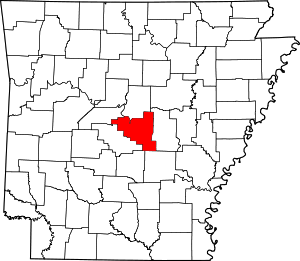
Back مقاطعة بولاسكي (أركنساس) Arabic Pulaski County, Arkansas BAR Пуласки (окръг, Арканзас) Bulgarian পুলাস্কি কাউন্টি, আরকান্সাস BPY Pulaski Gông (Arkansas) CDO Пьюласки (гуо, Арканзас) CE Pulaski County (kondado sa Tinipong Bansa, Arkansas) CEB Pulaski County, Arkansas Welsh Pulaski County (Arkansas) German Κομητεία Πουλάσκι (Άρκανσο) Greek
Pulaski County | |
|---|---|
 Pulaski County Courthouse, in downtown Little Rock | |
 Location within the U.S. state of Arkansas | |
 Arkansas's location within the U.S. | |
| Coordinates: 34°44′32″N 92°17′09″W / 34.742222222222°N 92.285833333333°W | |
| Country | |
| State | |
| Founded | December 15, 1818 |
| Named for | Casimir Pulaski |
| Seat | Little Rock |
| Largest city | Little Rock |
| Area | |
• Total | 808 sq mi (2,090 km2) |
| • Land | 760 sq mi (2,000 km2) |
| • Water | 48 sq mi (120 km2) 5.9% |
| Population (2020) | |
• Total | 399,125 |
• Estimate (2023) | 400,009 |
| • Density | 490/sq mi (190/km2) |
| Time zone | UTC−6 (Central) |
| • Summer (DST) | UTC−5 (CDT) |
| Congressional districts | 1st, 2nd, 4th |
| Website | pulaskicounty |
Pulaski County is a county in the U.S. state of Arkansas. With a population of 399,125 as of the 2020 United States Census, it is the most populous county in Arkansas.[1] The county is included in the Little Rock–North Little Rock–Conway metropolitan area. Its county seat is Little Rock,[2] which is also Arkansas's capital and largest city.
Pulaski County is Arkansas's fifth county, formed on December 15, 1818, alongside Clark and Hempstead Counties. Pulaski County is named for Brigadier General Casimir Pulaski, a Polish-born Continental Army officer who was killed in action at the Siege of Savannah during the Revolutionary War. The county was the site of the Battle of Bayou Fourche on September 10, 1863. The Union army took control the same day and occupied Pulaski County until the end of the Civil War. The county was home to Willow Springs Water Park, one of the oldest water parks in the nation, which opened in 1928 and closed in 2013.
- ^ Cite error: The named reference
2020 Censuswas invoked but never defined (see the help page). - ^ "Find a County". National Association of Counties. Retrieved June 7, 2011.

